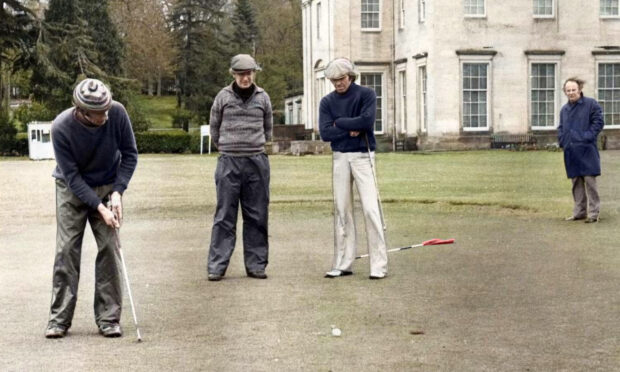On August 18 1909 Dundee Hibernian stepped out in front of 7,000 at their new Tannadice home.
It was the first fixture of the team that would go on to be known as Dundee United and Tannadice would progress from a stadium erected in days to a top-flight football park.
Here, we take a look back on the 112-year history of Dundee United’s home ground.
The land Tannadice sits on was a football park well before Dundee Hibernian took over the lease, with the ground first used for football in the 1870s and known as Clepington Park.
A number of local teams made Clepington Park their home throughout the late 19th Century with the Dundee Wanderers playing there from 1894 until the Dundee Hibs took over in 1909, including during their one-season stint as part of the Scottish Football League.
In 1909, when the Dundee Hibernian team were formed, they needed to find a home ground so club secretary Pat Reilly took the controversial step of offering the Clepington Park landlords more money than the Wanderers were paying, with the aim of gaining a ready-made home ground.
However, after the news reached the Wanderers that the season would be their last at their home ground, fury erupted and they decided to tear down the grandstand, changing rooms, fencing and even the goalposts.
The ready-made ground Pat Reilly and the committee had hoped for was no more.
The committee consisted of the aforementioned Pat Reilly as Secretary, Baillie Tom Hannick as President, Samuel Johnstone as vice-President, Thomas Timmons as treasurer and Patrick Doyle.
Thomas Heraughty, James Glover, John Kennedy, Thomas Malone and John Naulty completed the group.
Dundee Hibernian still took on the lease, though, and it was given its new name of Tannadice Park in homage to the street it sits on.
The committee had to erect new structures at the park in a tight timescale, with the development of the new Tannadice reported by us on July 21 1909: “The pavilion is a splendid two-storey structure built of brick, containing two large dressing-rooms, two committee rooms, press box and referee’s room.
“The pavilion will be lit by electricity. The stand on the road side will be the whole length of the field and will seat about 1,000 people.”
On August 18 1909 the Hibernian of Dundee faced the Edinburgh Hibernians for the park’s first game.
The match, played in front of roughly 7,000 spectators, saw the home side, who at the time played in green and white, draw 1-1 with the away team, Dundee Hibs player Jamie Docherty scoring the team’s first goal.
The original capacity of Tannadice Park was around 10,000; however, in 1913 the terraces were specially extended and additional temporary seating was erected for a Qualifying Cup tie against Forfar Athletic, which allowed the record attendance of roughly 15,000 to be accommodated.
The team ran out under the new name of Dundee United for the first time at the start of the 1923-24 season, with team directors also deciding on a change of colours to black and white.
No improvements to the ground were made until Dundee United won promotion to Division One for the first time in 1925.
The Scottish League Management Committee informed the club that Tannadice would be subject to an inspection during the close season to ensure that it was up to the standard required so the club decided to buy the park for £2,500, after leasing the ground for 16 years.
Following the purchase, extensive refurbishments took place with proper terraces constructed; the pavilion was given a facelift and new turnstiles were built.
During the close season of 1957, an important development took place with the construction of the Shed, which was opened in September of that year.
The new Main Stand, opened in August 1962, was the first in Scotland to be constructed with a cantilever roof to provide column-free viewing for spectators.
The stand was also the first in Scotland to have a glass-fronted lounge for the benefit of sponsors, which was opened in 1971 and overlooked the pitch.
Further improvements came when undersoil heating was installed during the close season of 1985, at a reported cost of £100,000.
Unfortunately for the team, the first time the undersoil heating was called into action – following heavy snowfall that started during the first leg of Uefa Cup third round tie against Neuchâtel Xamax on November 27 1985 – the system failed.
For a period in 1990, Dundee United considering sharing a new stadium with Dundee FC, but decided instead to redevelop Tannadice in 1991.
Many modifications were made to bring the stadium up to modern standards, with the George Fox stand being built in 1992 and the East Stand constructed in 1994, before being renamed the Eddie Thompson stand in 2008.
The latest stand to be constructed was the Fair Play stand in 1997.
Tangerine plastic seating was installed in the West Stand at the same time, the development making Tannadice an all-seater stadium.
In 2009 the traditional floodlights were removed and replaced with a brighter, roof-mounted lighting system, and in 2010 the original wooden seats in the Jerry Kerr stand were replaced.
The stadium has remained largely unchanged since those updates with the boys in tangerine looking to call Tannadice home far in to the future.


















